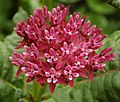| Purple milkweed | |
|---|---|
 | |
| Scientific classification | |
| Kingdom: | Plantae |
| Clade: | Tracheophytes |
| Clade: | Angiosperms |
| Clade: | Eudicots |
| Clade: | Asterids |
| Order: | Gentianales |
| Family: | Apocynaceae |
| Genus: | Asclepias |
| Species: | A. purpurascens |
| Binomial name | |
| Asclepias purpurascens | |
Asclepias purpurascens, or the purple milkweed, is a herbaceous plant species. It is in the genus Asclepias , making it a type of milkweed. It is native to the Eastern, Southern and Midwestern United States similar to the range of the common milkweed (Asclepias syriaca). The plant gets its name from the flowers that first develop a pink color but then turn darker purple as they mature. Unlike common milkweed, purple milkweed prefers some shade and is considered a plant of partial shade. It is also considered an indicator of oak savanna, especially in Wisconsin. [1] The species rarely produces seed pods which are smooth, instead of the rough warty ones produced by common milkweed. [2]











